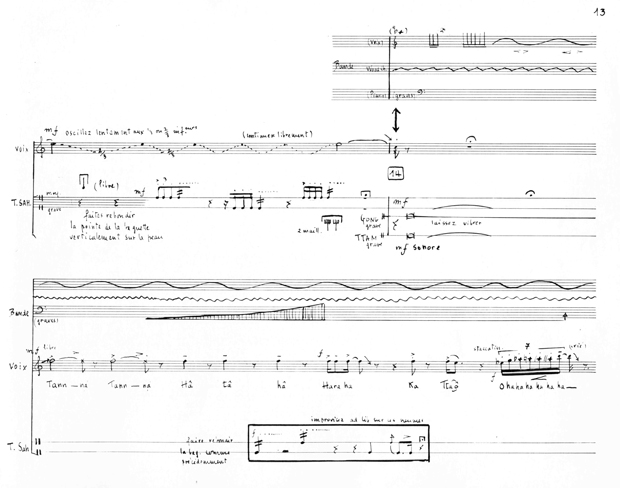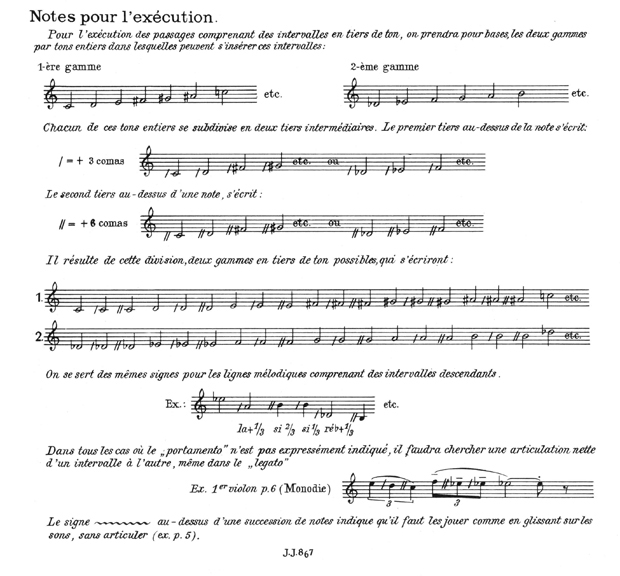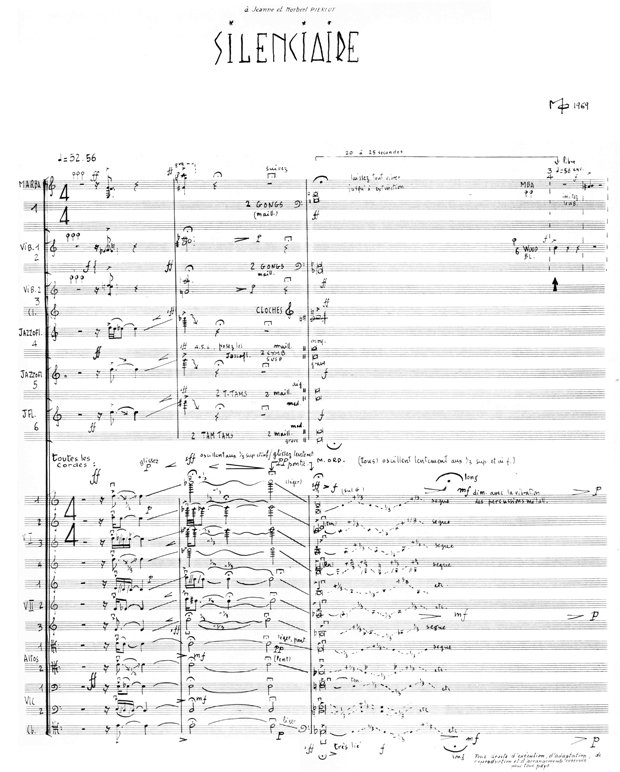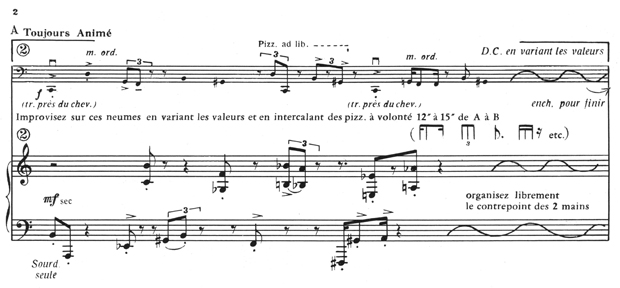 © D.R.
© D.R.Maurice Ohana
French composer of Spanish descent born 12 June 1913 in Casablanca; died 13 November 1992 in Paris.
Do you notice a mistake?
Survey of works by Maurice Ohana
An influential musical figure of the second half of the 20th century, Maurice Ohana – similar to Henri Dutilleux a generation before – followed his own path, keeping his distance from the dominant trends of his time. In whatever genre he tried, Ohana’s music attempted to set sound free, to stage it in a way that created an imaginary folklore that mixed the popular and the classical. “Sounds, by their very essence, cannot express anything,” he explained. “But they can orient the listener’s awareness of certain aspects of things, simply with the title, or a fragmentary text that shows up in the music, creating a kind of imaginary theatre in the mind.” Ohana’s work came directly from his intuitions, to which he gave form at the piano; they were imbued with the countries, civilizations, and encounters that marked his life.
“To compose is inescapably to explore your own roots”
Born in Casablanca of a British father and a Spanish mother, Ohana spent most of his childhood in Morocco. Between 1927 and 1929, he spent some time in French Basque country, where he gave his first piano recitals. In 1932, he moved to Paris to study architecture, but rapidly abandoned it to focus exclusively on piano. Although talented, he decided after the Second World War to set aside his piano career and devote himself entirely to composing. In 1947, he founded the group Zodiaque with composers Alain Bermat and Pierre de la Forest-Divonne, joined by Stanislaw Skrowaczewski and Sergio de Castro the following year. Zodiaque promoted freedom of expression against ideologies and systems, which Ohana would pursue as a lifelong guiding principle, drawing inspiration from his varied, hybrid background. Early on, his focus was on Spain; over time, he turned to the musical cultures of the Mediterranean Basin, Sub-Saharan Africa, and then further afield, to other continents.
Ohana’s first compositions clearly show his strong attachment to the culture of the Iberian Peninsula. Starting in the mid-1950s, he found significant inspiration in the poetry of Federico Garcia Lorca (Deux Mélodies sur des poèmes de Federico Garcia Lorca) and made arrangements of Spanish popular songs. This he would continue to do throughout his life, in a kind of “personal diary.” Ohana’s work contains several tributes to Lorca, notably in Le Guignol au gourdin, l’Anneau du Tamarit – whose title is a reference to the Lorca’s last poetry collection, Divan del Tamarit – or in Tiento – an echo of the poem Cante jondo. Spanish popular culture was also a lifelong source of inspiration for Ohana’s music, which often makes references to cante jondo – an Andalusian song tradition with roots in ancient musical systems, particularly from India – to flamenco – and tientos in particular – or to saetas – Andalusian religious songs improvised from windows and balconies during Holy Week processions, which “pull together all of the spiritual currents of the Mediterranean world.” Without ever falling into imitation, Ohana assimilates rhythmic structures (as in Trois Graphiques) or melodic phrasing (as in the third of Trois Caprices for piano, the central movement of his concerto for piano and orchestra, and the second of his four choreographic etudes). He also makes reference to specific linguistic elements or techniques, such as rasgueado – a strumming technique for guitar using the fingernails that creates a fierce, dense sound, rich in attacks and harmonics – present in his compositions for guitar, but elsewhere, too – he sometimes gives the instruction “fouetté, rasgueado-style,” notably in the fifteenth of his twenty-four preludes for piano.
Llanto por Ignacio Sánchez Mejías, Cantigas, La Célestine… all of these seek to magnify the richness of Spanish culture. The lament he wrote as a tribute to the toreador Ignacio Sánchez Mejías (1891-1934) is an impressive sonic fresco for choir, orchestra, and narrator, built around a Lorca poem with the same title, in which Ohana puts to music the wrenching drama of a country under the thumb of the Franco regime. Cantigas is a cycle of six pieces based on ancient texts, inspired by the 423 cantigas transcribed in Neumatic notation by Alfonso X the Wise, a treasure trove that is “the essence of all of the music brought by the successive migrations that crossed ancient Spain.” For his opera La Célestine, which took more than five years to compose, Ohana, with the support of philosopher Odile Marcel, adapted the eponymous text by Fernando de Rojas, calling it into life through sound, in the sense that the libretto had to be adapted to the music, rather than the contrary. The composer favored the phoneme over the word, adopting methods of composing and cutting closer to cinema than to opera. Other Spanish sources of note are Cervantes’ Don Quixote, which Ohana set to music in one of his first opus, The Enchanted Inn (La Venta encantada, later removed from his catalogue) and later in Images de Don Quichotte; and Goya, whose striking contrasts created by plays of light and shadow he sought to reproduce in sound, in Trois Caprices, Si le jour paraît..., and Cinq Séquences.
During the five and a half years he served in the British military, Ohana recalled that he had taken the following scores with him everywhere he went: Claude Debussy’s Prélude à l’après-midi d’un faune and Trois Nocturnes, Manuel de Falla’s Les Tréteaux de maître Pierre, and Maurice Ravel’s Piano Concerto for the left hand. The work of these three composers formed the foundation on which Ohana built his own musical language. Not surprisingly, he often paid tribute to them in various ways in his work. The fourth of his 12 Etudes d'interprétation for piano was written for the left hand “in memory of Maurice Ravel,” and Swan Song, based on Ronsard’s poem of the same name, was also used by Ravel in one of his songs. The instrumentation in Le Guignol au gourdin and Sacral d'Ilx refers, respectively, to Tréteaux de maître Pierre and to Debussy’s unfinished fourth sonata for oboe, horn, and harpsichord. Tombeau de Claude Debussy, a vibrant homage composed in honor of the centenary of Debussy’s birth, is a pivotal piece that reveals certain key traits of Ohana’s language; for example, the importance of percussion, the arrangement of instruments in a way that aims to transcend the fusing of timbres, exploration of the microtonal universe, clusters and resonances, play with contrasts produced by the alternation of melodic patterns and homophonic harmonic masses, or the deconstruction of the text into syllables. “It was through this work that I discovered a new opening in music, with which I then worked a great deal; it is very far from all of the early works I wrote, where one obviously cannot deny that the ghost of Debussy is fairly present.”
“I claim to have an immemorial memory, that goes back to the time when man was not what he is now.”
The titles of most of Ohana’s scores plunge us immediately into ancestral eras: the composer is just as likely to draw inspiration from mythology (as in Sibylle, Kypris, Livre des Prodiges) as he is from the primitive liturgy of the 2nd century (Synaxis). By reincarnating these myths, by evoking ancient civilizations and their rituals, forgotten by modern societies, Ohana was honoring an “immemorial memory.” Voice and percussion are foregrounded in both because they stand outside the tempered system; their primitive nature – in the sense that they are considered to be the earliest forms of musical expression – is also key. To ensure that a text is perfectly intelligible, the composer makes use of a narrator, around whom the music’s action is organized. But at moments when he wished to return the voice to “its primitive state, its wildness, to liberate it from the preciousness of bel canto,” he did away with vibrato and focused on phonemes, rather than words, favoring murmurs, cries, and all sorts of onomatopoeic sounds over melodic song. In Sibylle, for example, he employed eight words from different languages, pulling them apart semantically [Figure 1].

Figure 1: Sibylle (1968) for soprano, percussion and tape, © Editions Jobert, Paris.
Generally speaking, Ohana used percussion to underscore the tribal, ceremonial dimension he sought to bring to his work. Percussion began to play a central role in his composition starting with four choreographic Études, written in 1954. These were initially composed for the dancer Dore Hoyer and her husband, who was a percussionist, then adapted for four performers. The definitive version of the piece was completed in 1963, for six percussionists. The Percussions de Strasbourg, for whom this last version was created, brought it great renown. Similar to Varèse, Ohana did not see percussion only from a rhythmic perspective; for him, their main purpose was to build subtle blocs of harmony and timbre. One hears this in Silenciaire, for six percussionists and twelve strings, for example. Percussions appear in almost all of Ohana’s works for ensemble, as well as in many of his chamber music pieces (Sibylle, Etudes d’interprétation – N. 11 and 12, Miroir de Célestine). The word ending ‘ngô’ – which is found in a certain number of words describing African dances as well as the instruments that accompany those dances – appears in almost a dozen of Ohana’s works, starting with Sorôn-Ngô. Others include his third string quartet, subtitled Sorgin Ngô, and Farân-Ngô (the final movement of his second string quartet), in which Iberian and African rhythms are used to evoke the atmosphere of a nighttime party, and whose percussive quality is prominent. In T'Hâran-Ngô, one of the composer’s rare symphonic scores, the choreographic dimension is predominant: Ohana was seeking to reproduce the peculiar mood created by incantational dances in African tribal ceremonies. Ohana’s fascination with non-European ritual, a foundational aspect of his music, comes from his time in Madagascar, Kenya, and Uganda… during his wartime service in the British military.
Africa, its landscapes, its civilizations, and its ancestral rites nourished Ohana’s imagination extensively. His time in Kenya was pivotal to his subsequent stylistic orientations. For one thing, it was in Kenya that he met the South African poet Roy Campbell, who had translated Lorca, and who brought Llanto por Ignacio Sánchez Mejías to Ohana’s attention. In Kenya he also attended village ceremonies that celebrated nature and divine spirits; later on, in his music, he would seek to reproduce the incantational force and the magical dimension of these ceremonies, cultivating a ritual aesthetic. The epigraph to T'Hâran-Ngô reads, “Conjuration, contemplation, glorification of nature’s primal forces. Star, light, and night. Fire, earth. The harvest and the trees. Air and water, silence and absence.” References such as this one, which are everywhere in his work, reveal the composer’s metaphysical and naturalist inclinations. Ohana also ascribed mysterious meaning to numbers, letters, and symbols. In Office des Oracles and Lys de Madrigaux, the number 3 plays a central role in the organization of sequences and vocal groupings. Many of the titles of his pieces begin with the letter S, which could be interpreted as a vertical representation of the infinity symbol. Certain scores, such as Signes, are interspersed with symbols representing the life phases of a tree at different seasons, evoking the passage of time. Others evoke the sun, either with the letters OANA placed as a signature at cardinal points in the score, or in their section titles (“Soleil renversé” in Livre des Prodiges, “L’aube” in Si le jour paraît..., for example). If Ohana’s music sparks mystery and enchantment, it is in part due to this highly personal way of invoking primal forces and ordering the sound according to ancestral rituals belonging to extra-European civilizations: African culture in T'Hâran-Ngô, Mayan tradition in Synaxis, or Afro-Cuban culture in Avoaha, for example. Ohana was in fact quite superstitious, and to ward off bad luck, did not like to reveal his creative process. Indeed, the expression conjurer les sorts (not to tempt fate) appears in Livre des Prodiges and La Célestine.
“If you have a “blast furnace” powerful enough to melt everything together […], a style emerges.”
Ohana’s music is an invitation to travel – to traverse continents and eras. He was sometimes criticized for the manifest diversity of his sources of inspiration, but it was this diversity that allowed him to craft his singular style, which resolutely embraced emotion and made him stand out from all other composers. This mixing together of cultures and influences was latent in earlier works such as his Concertino for trumpet and orchestra in 1950, but would become a constant in his subsequent work. The music of the Mediterranean basin and of Africa helped to form the bedrock of his style, but Ohana continued to add in other musical traditions as he evolved, notably from Cuba, the Caribbean, Brazil, and the United States. References to jazz, blues, and Negro spirituals are discernible in several of his scores: “In Memory of Fats Waller and Count Basie” (Étude d’interprétation N. 9 for piano); “To be sung in the style of Negro Spirituals, with no vibrato and a bit freely” (Swan Song), “Think of Thelonious Monk” (third string quartet), “Here’s to you Satchmo” (Concerto for cello “In dark and blue”). The Far East was also a source of influence for the composer, who, in Sibylle and Syllabaire pour Phèdre, nodded to the Japanese Noh tradition. The Trois Contes de l'Honorable Fleur show both his affection for kabuki and for the puppets and shadow play of Chinese theatre, which he discovered in Paris in 1954.
The idea of creating theatrical music rather than coming up with a new genre of musical theatre haunted the composer. This preoccupation appears as early as Stream: “stage suggestion capable of inspiring, as in Chinese opera, mime, shadow, or mask play.” Music, acting, lights, stage sets, accessories, costumes… all of these played an equally important role in the service of the artistic vision. Ohana’s reading of Japanese legends transcribed from that culture’s oral tradition inspired him to write his own tales, where once again he turned to the themes that obsessed him: mystery, evil, magic. Odile Marcel used these texts to write the libretto for Trois Contes de l'Honorable Fleur, a chamber opera composed for Michiko Hirayama (the close collaborator, performer, and muse of Giacinto Scelsi), in which she played the roles of solo soprano, mime, and narrator. The score mentions the presence of “stage helpers” – silent figures who participate in the action and can be played by puppets, masked mimes, or shadows. At the end of the first tale, “Ogre eating young women in the moonlight,” for example, Ohana gives precise instructions for a shadow or puppet in the score, with directions such as “The head of a passer-by appears, listening. He moves closer to the Ogress. The passer-by approaches the Ogress with jerking steps; she snatches him up and swallows him.”
Ohana was perhaps most experimental in his stage music, operas, and illustrations musicales, and did not hesitate to explore certain technical possibilities found in the dominant musical trends of the time. Starting in the 1950s, he grew interested in contemporary technological developments – learning musique concrète with Pierre Schaeffer – and academic research, notably in ethnomusicology. It was then that he realized that “music could be thought of as part of an organic substance that would be a raw material, thus leading to reflection on sound material”. Between 1948 and 1966, he composed ten illustrations musicales, including three with tape, with the idea of creating radio theatre in which words, written by celebrated authors, and music would blend together as one. This work, done in close collaboration with sound engineers and the producers of literary radio shows, revealed the composer’s interest in Greek tragedy – he created music for no fewer than four of Gabriel Audisio’s adaptations of plays by Euripides – and in the technical possibilities offered by the studio.
Film – with its rapid scene changes and short sequences, modified lighting, and contrasting rhythms – had a deep effect on the composer, as well. Thus, in lyric works such as Autodafé and La Célestine, he built and arranged sequences inspired by cinematographic structuring. He also did not hesitate to make use of space to intensify dramatic effect, as in Autodafé, Office des Oracles, or Lys de Madrigaux, in which the performers move during the course of the performance. While he rejected the primacy of construction in music, so prized by the avant-garde Ohana mistrusted, the composer did nevertheless engage in experimentation, and was particularly inventive in the field of microtonality. Micro-intervals appear briefly in the violin part of Llanto por Ignacio Sánchez Mejías, and then regularly throughout the 1960s, in an attempt to connect to “lost temperaments.” Ohana’s discovery of Julian Carrillo’s microtonal instruments in Paris in 1955 inspired him to use the third-tone scale, which also appears in Arab and Andalusian music [Figure 2].

Figure 2: Notes for Cinq séquences (String Quartet N. 1) (1962-63), © Editions Jobert, Paris.
The third-tone scale favors melodic continuity and creates a unique harmonic mood, and Ohana employed it often to produce microtonal oscillations [Figure 3] or paired it with semi-tones, creating complex pulsations. These writing techniques are archetypical of his musical language, helping to create the “Ohana sound.”

Figure. 3: Silenciaire (1969) for string and percussion, © 1993 Gérard Billaudot Editeur SA, Paris.
Starting in the 1960s, Ohana also began introducing aleatoric elements into his scores. In Silenciaire and l’Office des Oracles for example, it is the conductor who decides on the order of the sections. More generally, the composer often arranged musical units – which contained a set of notes or a rhythmic pattern – that performers were invited to repeat freely, for an approximate duration, making it possible to constantly vary the degree of coordination among and the density of the parts. Sorôn-Ngô has two possible endings, and several times its pianists must improvise with neumes, a compositional process that can be found in most of his chamber music pieces, such as Noctuaire [Figure 4]. At the end of Étude d’interprétation N. 12, which includes numerous free elements, the percussionist can, if they wish to, actually improvise for four measures, so long as they use the instruments indicated in the score. Adding these chance sections creates a certain rhythmic flexibility that augments the improvised and free nature of his music.

Figure 4: Noctuaire (1975) for cello and piano (used with permission from Editions Durand Paris).
Reluctant to make use of large orchestra formations, Ohana preferred smaller instrumental ensembles – albeit with a vast array of percussion instruments – often adding solo instruments to them. The harpsichord, which he favored for its percussive clarity and biting timbre, appeared early on in Llanto por Ignacio Sánchez Mejías. As a solo instrument, Ohana returned to it regularly in his compositions. His meeting with the harpsichordist Elisabeth Chojnacka in the late 1960s gave rise to several works, including Chiffres de clavecin, Sacral d'Ilx, and Miroir de Célestine – a version for harpsichord and percussion of some material from his opera La Célestine. His work with the harpsichord went hand in hand with his work for guitar. In Solea, the harpsichord is accompanied by two guitars, while Tiento can be performed on either harpsichord or guitar. Ohana found the register of the six-string guitar too limiting, however: he worked with guitarist Narciso Yepes to develop a ten-string guitar, thereby creating an enriched palette of harmonics and resonances while maintaining the possibility of producing clusters. Perfected in 1964, this guitar led to the transcription of already existing pieces such as Tiento and Trois Graphiques, as well as the composition of new ones, including Cadran lunaire and Si le jour paraît.... With the medieval organ expert Monique Rollin, Ohana also created a third-tone zither that was used for the first time in 1956 in the radio illustration Les Hommes et les autres, and then almost systematically in his work up to Syllabaire pour Phèdre.
The composer maintained a peculiar relationship with the piano, which he liked to describe as an 83-toothed minotaur. The piano had been his entry into the musical world, first as a concert performer, and, starting in 1943, as a composer. Indeed, Enterrar y callar, the first of his Trois Caprices, is the first official work in his catalogue. “I search on the piano, I improvise, and for me it was the way to access music through sound, more than through speculations or conceptual work,” Ohana explained. The piano was the instrument he used to compose and orchestrate his works. After his Sonatine monodique and Trois Caprices, composed in the 1940s, he waited several years before showcasing the instrument again in certain pieces. The long cadence of Tombeau de Claude Debussy, shows his reconciliation with it. After this work came Synaxis, a concerto for 2 pianos, 4 percussions and large orchestra, Sorôn-Ngô for 2 pianos, and Twenty-four Préludes and Douze Etudes d'interprétation, cornerstones of the solo piano repertoire of the second half of the 20th century. Ohana’s writing for piano focuses on the articulation of resonances – with the constant use of the third pedal, which makes it possible to escape temperament by sculpting the piano’s resonance and timbre by filtering harmonics – on an architecture of silences and clusters, often obtained using a felt-covered ruler – and on the precision of dynamics and attacks, contrasts between melodic lines and harmonic masses …
*
“In music, intelligence and speculation should play only a minor role, behind intuition and sensibility,” Ohana liked to say. If his work may be criticized for a certain lack of formal structure, what stands out is the sensitivity with which the composer arranged sections depending on their degree of similarity or contrast.
Ohana, in a highly personal synthesis, and in the manner of a sound alchemist, was able to expand the spectrum of creative possibility by making music that had both ferocity and sparkle, that mixed the ingredients of traditional folklore and modern writing techniques. Abounding in contrasts, built on an acute sense of dramaturgy, with an unbridled palette whose timbres embraced a wide-open mix of cultures, his music can be heard as a ritual that sings the history of civilization and of nature. With only his instinct as a guide, rejecting any notion that the popular and the classical arts might be unequal, Ohana built his own style: a style that was elevated by a unique sound, full of mystery – a dark sound, to quote Lorca.
Note: all citations of Maurice Ohana are taken from Maurice Ohana, written by François Porcile and Édith Canat de Chizy, Paris: Fayard, 2005.
Do you notice a mistake?